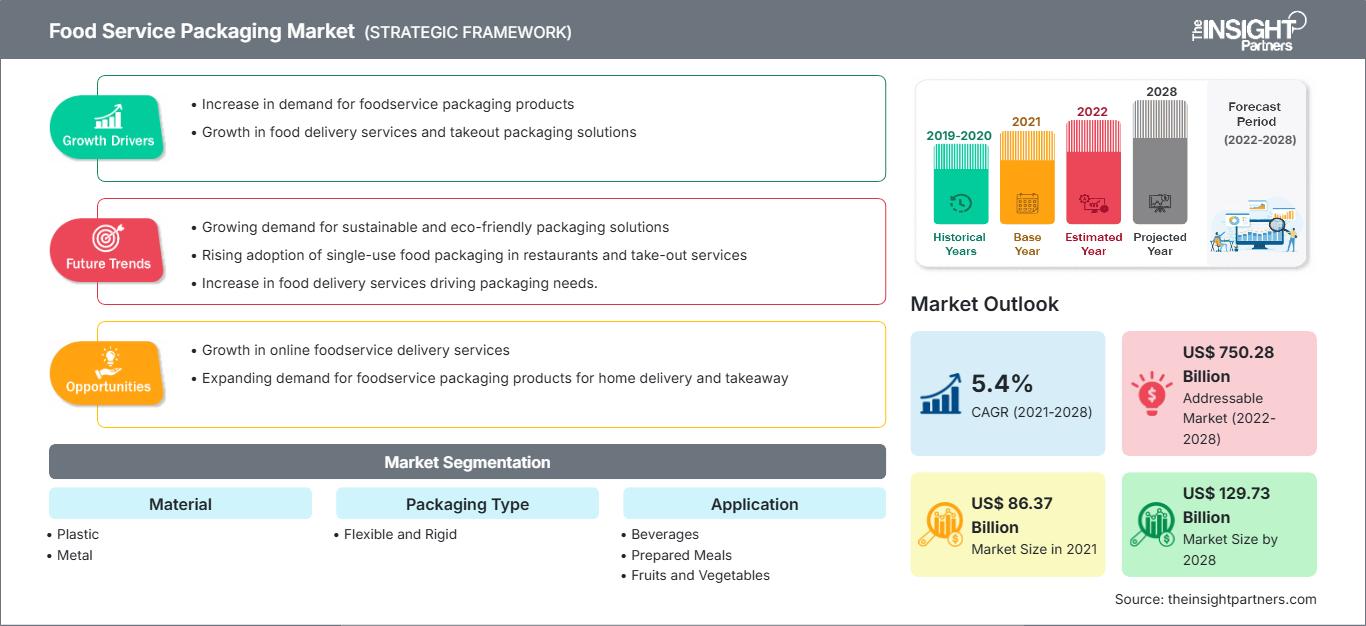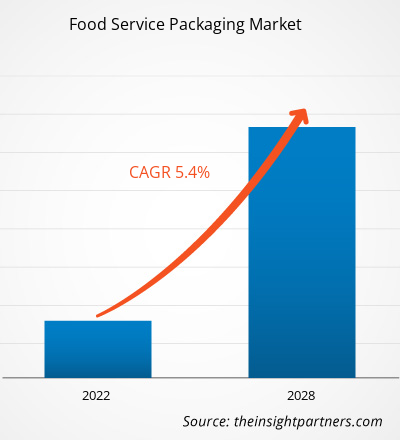[調査レポート]食品サービス用包装市場は、2021年に863億7,208万米ドルと評価され、2028年には1,297億2,893万米ドルに達すると予測されています。2021年から2028年にかけて5.4%のCAGRで成長すると見込まれています。
食品サービス用包装には、店内飲食、テイクアウトの食品サービス施設、宅配における調理済み食品や飲料の提供または包装に使用される製品が含まれます。食品サービス用包装製品には、温かい飲み物や冷たい飲み物用のカップ、皿、トレイ、ボウル、バッグ(個包装およびテイクアウト)、容器と蓋、カトラリーと食器、アイスクリームカップ、スープカップ、飲料キャリアなどがあります。これらの製品は、微生物、空気、湿気による汚染から食品を保護します。
2020年、アジア太平洋地域は世界の食品サービス用包装市場で最大の収益シェアを占めました。アジア太平洋地域の食品サービス用包装市場は、フルサービスレストランやカフェなどからの食品サービス用包装製品への高い需要が牽引しています。この地域では、オンライン食品注文プラットフォームの利便性により、様々な食品サービス用包装製品への需要が急増しています。中国とインドは、アジア太平洋地域における市場の主要な国です。インドでは、都市部住民の外食習慣の高まりが市場の成長を牽引しています。
要件に合わせてレポートをカスタマイズ
レポートの一部、国レベルの分析、Excelデータパックなどを含め、スタートアップ&大学向けに特別オファーや割引もご利用いただけます(無償)
食品サービス向け包装市場: 戦略的洞察

- このレポートの主要な市場動向を入手してください。この無料サンプルには、市場動向から見積もりや予測に至るまでのデータ分析が含まれます。
COVID-19パンデミックによる食品サービス用包装市場への影響
レポートの一部、国レベルの分析、Excelデータパックなどを含め、スタートアップ&大学向けに特別オファーや割引もご利用いただけます(無償)
食品サービス向け包装市場: 戦略的洞察

- このレポートの主要な市場動向を入手してください。この無料サンプルには、市場動向から見積もりや予測に至るまでのデータ分析が含まれます。
COVID-19パンデミックは、ロックダウン、渡航禁止、事業閉鎖により、様々な国の経済や産業に影響を及ぼしました。2020年には、国内外の境界が閉鎖されたことでバリューチェーンが混乱し、様々な産業が操業を減速せざるを得ませんでした。パンデミックは、様々な国の政府当局によって課された制限により、製造プロセスを混乱させました。COVID-19の急速な蔓延は、食品サービス業界に前例のない課題をもたらしました。世界中の様々な国で社会的距離政策によりレストラン、バー、クラブが閉鎖されたことは、食品サービス用包装製品の需要に悪影響を及ぼしました。
しかし、テイクアウトやオンラインでの食品注文の増加は、レストランにチャンスをもたらしました。 2021年には経済活動の活性化が始まりました。レストラン、バー、クラブ、その他の食品サービス店の開店に伴い、様々な食品サービス用包装製品の需要がさらに高まっています。
市場洞察:包装製品の生産能力の拡大
賞味期限が長く、品質が管理された新鮮な食品を消費したいという消費者の関心の高まりにより、食品包装製品の需要が高まっています。この要因は、食品包装メーカーが新しい安全な包装を設計・開発するのに役立っています。さらに、人口増加は、食品生産部門に食品廃棄を削減するための強化された食品包装ソリューションを採用するようさらなる圧力をかけています。したがって、食品業界を改善するための現在のアプローチは、食品包装のための新しい革新的な技術の開発に重要な投資を行うことで、食品の損傷と廃棄を削減することを目指しています。
材質に関する洞察
材質に基づいて、世界の食品サービス用包装市場は、プラスチック、金属、その他に分類されています。 2020年、世界の食品サービス用包装市場では、プラスチック分野が最大のシェアを占めました。プラスチック包装は柔軟な包装形態です。これにより、食品サービス提供者は、顧客の要件に応じて包装の形状、スタイル、サイズをカスタマイズできます。プラスチック包装は軽量であるため、食品サービス業界では好まれています。プラスチック包装のこれらの利点は、食品サービス業界の顧客を惹きつけています。したがって、プラスチック製の食品サービス用包装市場は急増しています。
アプリケーションの洞察
アプリケーションに基づいて、世界市場は飲料、調理済み食品、果物と野菜、パンと菓子、乳製品、その他に分類されています
。
調理済み食品セグメントは、2020年に世界の食品サービス用包装市場で最大のシェアを占めました。調理済み食品の包装には、バイオベースおよび生分解性プラスチックとアルミニウムが使用されています。Graphic Packaging International, LLC、Amcor PLC、Cambay Technopack Private Limited、Huhtamaki Global、AR Packaging、WestRock Company、Genpak, LLC、Vegware Ltd、BeGreen Packaging、Stora Ensoは、世界の食品サービス用包装市場で活動している主要企業です。世界の食品サービス用包装市場で活動している企業は、研究開発活動への投資、新製品の発売、合併・買収などの戦略に常に注力しています。市場プレーヤーは、顧客の需要を満たすために高品質の製品を提供することに重点を置いています。
レポートのスポットライト
- 食品サービス用包装市場における進歩的な業界動向。プレーヤーが効果的な長期戦略を策定するのに役立ちます
- 先進国と発展途上国で採用されているビジネス成長戦略
- 2019年から2028年までの食品サービス用包装市場の定量分析
- 食品サービス用包装の世界的需要の推定
- 業界で事業を展開しているバイヤーとサプライヤーの有効性を示すポーターのファイブフォース分析
- 競争の激しい市場シナリオを理解するための最近の動向
- 市場の動向と見通し、および食品サービス用包装市場の成長を促進および抑制する要因
- 商業的関心を支え、市場の成長につながる市場戦略を強調することにより、意思決定プロセスを支援
- さまざまなノードにおける食品サービス用包装市場の規模
- 詳細な概要と市場のセグメンテーションと食品サービス用包装業界の動向
- 有望な成長機会のあるさまざまな地域における食品サービス用包装市場の規模
食品サービス向けパッケージ市場の地域別分析
The Insight Partnersのアナリストは、予測期間を通じて食品サービス用包装市場に影響を与える地域的な傾向と要因を詳細に解説しています。このセクションでは、北米、ヨーロッパ、アジア太平洋、中東・アフリカ、中南米における食品サービス用包装市場のセグメントと地域についても解説しています。
食品サービス向けパッケージ市場レポートの範囲
| レポート属性 | 詳細 |
|---|---|
| の市場規模 2021 | US$ 86.37 Billion |
| 市場規模別 2028 | US$ 129.73 Billion |
| 世界的なCAGR (2021 - 2028) | 5.4% |
| 過去データ | 2019-2020 |
| 予測期間 | 2022-2028 |
| 対象セグメント |
By 材質
|
| 対象地域と国 | 北米
|
| 市場リーダーと主要企業の概要 |
|
食品サービス用パッケージ市場のプレーヤー密度:ビジネスダイナミクスへの影響を理解する
食品サービス向けパッケージ市場は、消費者の嗜好の変化、技術の進歩、製品メリットへの意識の高まりといった要因によるエンドユーザーの需要増加に牽引され、急速に成長しています。需要の増加に伴い、企業は製品ラインナップの拡充、消費者ニーズへの対応のための革新、そして新たなトレンドの活用を進めており、これが市場の成長をさらに加速させています。

- 入手 食品サービス向け包装市場 主要プレーヤーの概要
世界の食品サービス包装市場
材質
- プラスチック
- 金属
- その他
包装タイプ
- フレキシブル
- リジッド
用途
- 飲料
- 調理済み食品
- 果物と野菜
- ベーカリーと菓子類
- 乳製品
- その他
企業プロファイル
- Graphic Packaging International, LLC
- Amcor PLC
- Cambay Technopack Private Limited
- Huhtamaki Global
- ARパッケージング
- WestRock Company
- Genpak, LLC
- Vegware Ltd
- BeGreen Packaging
- Stora Enso
- 過去2年間の分析、基準年、CAGRによる予測(7年間)
- PEST分析とSWOT分析
- 市場規模価値/数量 - 世界、地域、国
- 業界と競争環境
- Excel データセット
最新レポート
関連レポート
お客様の声
購入理由
- 情報に基づいた意思決定
- 市場動向の理解
- 競合分析
- 顧客インサイト
- 市場予測
- リスク軽減
- 戦略計画
- 投資の正当性
- 新興市場の特定
- マーケティング戦略の強化
- 業務効率の向上
- 規制動向への対応




















 無料サンプルを入手 - 食品サービス向け包装市場
無料サンプルを入手 - 食品サービス向け包装市場